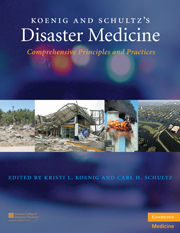Book contents
- Frontmatter
- Contents
- List of Contributors
- Contributor Biographies
- Foreword
- Preface
- Acknowledgments
- PART I CONCEPTUAL FRAMEWORK AND STRATEGIC OVERVIEW
- PART II OPERATIONAL ISSUES
- PART III CLINICAL MANAGEMENT
- SECTION A CBRNE AND HAZMAT
- 26 Explosive Events
- 27 Burn Patient Management
- 28 Clinical Aspects of Large-Scale Chemical Events
- 29 Biological Events
- 30 Nuclear and Radiological Events
- 31 Hazardous Material, Toxic, and Industrial Events
- SECTION B ENVIRONMENTAL EVENTS
- Index
- Plate section
- References
26 - Explosive Events
from SECTION A - CBRNE AND HAZMAT
Published online by Cambridge University Press: 05 August 2011
- Frontmatter
- Contents
- List of Contributors
- Contributor Biographies
- Foreword
- Preface
- Acknowledgments
- PART I CONCEPTUAL FRAMEWORK AND STRATEGIC OVERVIEW
- PART II OPERATIONAL ISSUES
- PART III CLINICAL MANAGEMENT
- SECTION A CBRNE AND HAZMAT
- 26 Explosive Events
- 27 Burn Patient Management
- 28 Clinical Aspects of Large-Scale Chemical Events
- 29 Biological Events
- 30 Nuclear and Radiological Events
- 31 Hazardous Material, Toxic, and Industrial Events
- SECTION B ENVIRONMENTAL EVENTS
- Index
- Plate section
- References
Summary
The opinions and assertions herein are the private views of the authors and are not to be construed as official or as reflecting the view of the United States government, Department of Defense, or Department of the Air Force. This is in part a government work. There are no restrictions on its use.
OVERVIEW
Explosive events occur in many settings. They can have a variety of etiologies, which can be accidental or intentional. Many blasts damage only property, but every explosion can be classified as a potential injury-creating event (PICE). It is the human impact with which this chapter is mostly concerned. Injuries may occur to individuals or groups. Massive and multiple explosions may affect entire communities or larger regions, resulting in a disaster situation. According to Noji, “A disaster is defined as a natural or manmade event that results in an imbalance between the supply and demand for existing resources.”
Most explosive events are unlikely to result in major catastrophes, as defined by Lumley and Ryan, “where the social fabric of a society is disrupted and the medical infrastructure fails.” Some important exceptions exist, however. A single bombing of the only hospital in a region may cause temporary failure of that local healthcare system, until external resources can be mobilized. Multiple, intentional explosions specifically targeting critical services may impact a larger population to a greater degree. A nuclear detonation would likely disable much of a city's infrastructure.
Keywords
- Type
- Chapter
- Information
- Koenig and Schultz's Disaster MedicineComprehensive Principles and Practices, pp. 393 - 422Publisher: Cambridge University PressPrint publication year: 2009



